If you are one of the many.
You are probably also wondering about an essential thing in calisthenics workout.
The amount of repetitions.
Honestly, I wish there was an easy way to explain it. I wish I could tell you: “Just do an X amount of repetitions and you will achieve your goals”.
But there isn’t.
The truth is repetitions and the amount of sets required differ per person.
It depends on your overall muscle composition and on your goals among many other factors.
Still, there are generally accepted ranges of repetitions which you can stick to.
The research on this is still lashing out in the dark, mostly.
The good news? We have a lot of evidence from people actually doing and experimenting themselves.
Here is what you need to know when it comes to repetitions.
Strength, Mass And Endurance
Strength and endurance are like a marathon runner and a power lifter.
Two ends of a continuum.
Strength is achieved through low amounts of repetitions where 1 repetition max shows your current highest level of strength.
Endurance is achieved through choosing easier exercises which are low in strength requirements and high in volume.
A power lifter for example lifts 3 times his or her own body weight in 1 rep.
A marathon runner is far from able to do this, but can run for hours at an end without serious fatigue.
One focuses on being able to generate as much power as possible in one move, while the other focuses on generating low amounts of power to do many moves.
There are therefore 5 points which you can take away from this comparison:
1. You can’t be a marathon runner and a powerlifter at the same time without losing at either the strength or endurance side.
2. If you want to develop strength you need to focus on lower reps and higher resistance, just like a powerlifter does.
3. If you want to be both a powerlifter and a marathon runner, you will need to find a balance between low repetitions and strength or high repetitions and endurance.
4. If your focus is on muscle mass (hyperthrophy) don’t be a powerlifter and don’t be a marathon runner.
5. Your repetitions under a certain load determine your muscle composition or what your muscles are capable of.
Note: I personally believe that muscle mass should never be your main objective. Mass should always be a result of or achieved in combination with instead of the reason for.
3 Types Of Muscle Fibers For Endurance And/Or Strength
Your body is composed of three sets of muscle fibers:
Slow twitch, adaptable and fast twitch fibers.
Slow twitch fibers have a high capacity for endurance and have the least potential for hyperthrophy.
Ever seen a muscular marathon runner? Probably not.
That’s why.
Fast twitch fibers fatigue very fast.
They can also contract very fast and are the primary fiber developed in power and strength fields like powerlifting.
Where an explosive activation of the muscles is required.
And adaptable fibers are somewhere in between
They can do both strength and endurance and will be used for whatever they are required.
Some people have more slow twitch fibers than others and the same goes for fast twitch fibers.
This means your body will simply react better to certain respones or types of training than other bodies.
A marathon runner might both be genetically more of a slow twitch guy, but he also needs to simulate his slow twitch muscles.
Simply having them in a higher quantity, doesn’t mean that he will actually be better at running a marathon than a powerlifter with mostly fast twitch cells who has been training day in day out.
This example does not mean that you are either slow of fast twitch, you need both fibers and you have both.
Some muscle groups have more than others and will respond to a certain type of training better than others.
In general the characteristics of your exercise determine your overall amount eventually.
So it’s not slow twitch or fast twitch, it’s not black or white, it’s both, but it larger or smaller amounts, depending on what you do with your body.
So genetics play their role, but only to the extent at which they are expressed.
And guess who determines that?
You.
The Best Rep Range For Strength, Mass And Endurance
So how does this all relate to actual repetitions?
If you want to increase strength you should stick to a 1-5 rep range in a progression that requires at least 80-100% of your maximum strength in 1 rep.
If you want to increase endurance you should stick to rep range higher than 12, in a progression that requires around 60% or less of your strength in 1 rep.
For hyperthrophy you will need to stick between a 5-12 rep range in which you will also have strength gains and endurance gains, this will usually be at around 70-80% of your maximum strength in 1 rep.
Which rep range is the best?
It honestly depends on you goals and how your body responds to different impulses.
Sometimes doing less reps at a high resistance of a certain move can really take you to the next level.
Other times doing more reps at a lower resistance does the same.
There are too many factors in play (Time under tension, muscle fibers, speed etc.) to simply say that the stated amount of repetitions will determine EVERYTHING.
But they are definitely important for your overall results (See diagram below).
Source: Overcoming Gravity
These reps are the amount of reps in a single set.
You might do multiple sets of a certain type of rep range.
Usually 3-5 sets of a 5-8 rep range before the muscle fatigue is too much for proper execution (See table).
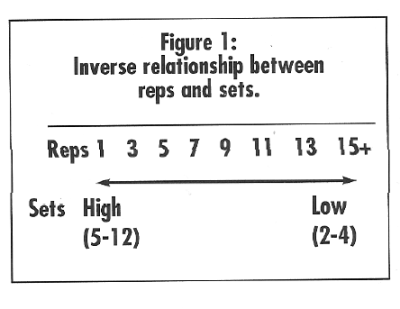 Source: The Poliquin Principles
Source: The Poliquin Principles
Reps And Putting Those Reps To The Test
I’m presenting you guys with a oversimplication, but sometimes that’s exactly what you need.
Knowing what repetition range you should stick to can be essential for getting the results you want.
Especially if all other factors such as dieting and resting and your overall hormones are in check.
So start experimenting with your rep ranges.
Set clear goals for what you want to achieve.
Because that’s exactly what’s at stake if you are just doing endurance while your goal is to gain strength.
Having this knowledge, can be pretty exciting, because now you can get serious.
So if you want to be a marathon runner, more of less.
If you want to be a powerlifter, less of more.
And if you want to master calisthenics, put those reps to the test.
Beast mode ON!

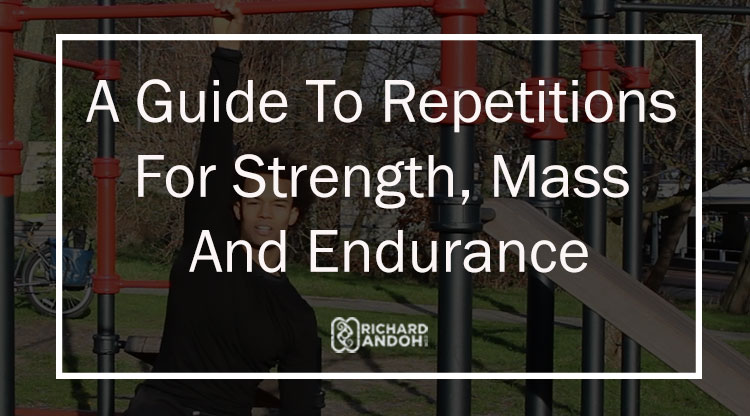


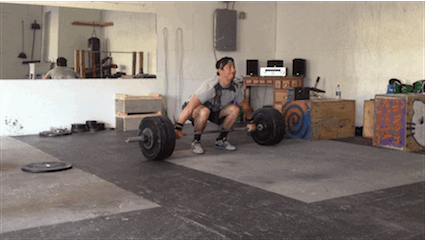
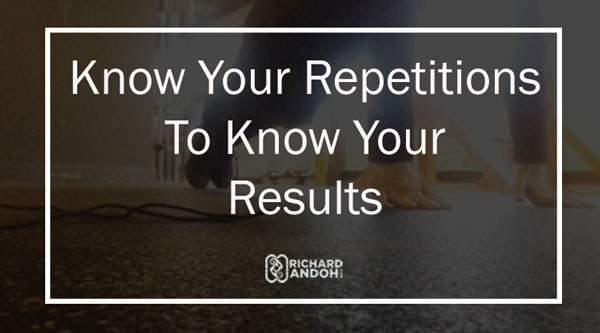
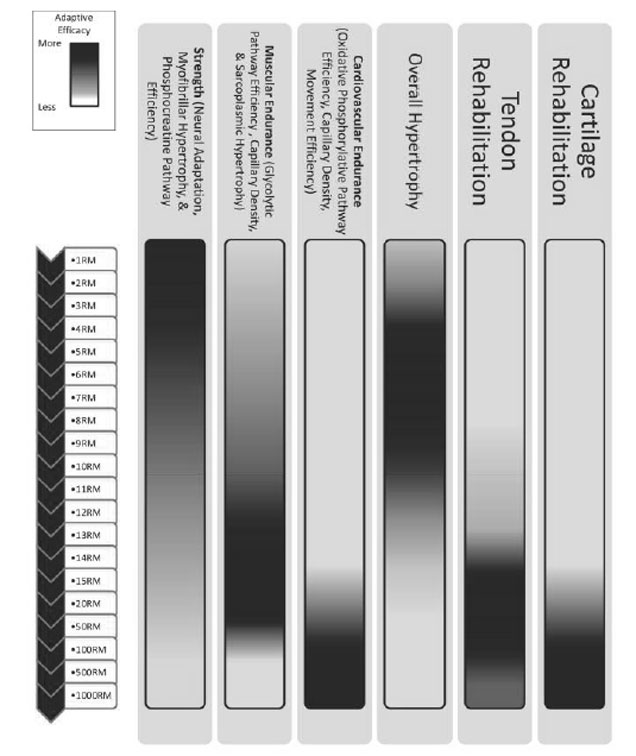
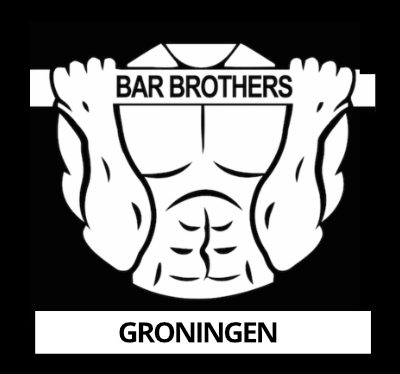
I don’t really understand the thing for strength. could you explain to me how long I need to be under tension for strength gains. what rep speed. Thank you man!
Hey Erik,
That’s a big point. It really depends on the different exercises, for now sticking to the given rep scheme and focusing on good quality execution will already be very beneficial as you start.
*Fist bump*
What would you recommend out of Straight sets vs Supersets?
A lot of suggested workouts always seem to be in supersets but when incorporating moves such as handstand push ups in my workouts I need to be as fresh as possible and straight sets with designated rest is better but then dips, push ups etc can be supersetted to good effect?
Bit of both or one or the other? I didn’t think transitioning from weights to bodyweight would be so complicated haha. I do understand that every body is different and I will need to find what works best for me over time but eager to hear your opinion.
Hey Paul,
Great question!
It really depends on a lot of factors, giving a precise answer would be beyond the scope of this website. Books have been written about it ;).
But you can find tons of information on this online.
*Fist bump*
I just started calisthenics and I want to know how many reps I should do for let’s say the pullup or dip to practice calisthenics skills. I like to do the maximum reps I can do on each excercise (pullup, dip, pushup, leg raise etc). Is this good for calisthenics? Thanks!
Hey Nick,
Great question.
It depends on your goals ;). What do you want to achieve?
*Fist bump*
Hey there! I’m a huge fan of your blog! You’ve really inspired me to pick up calisthenics as my workout choice.
I’m a professonal badminton player, and the sport requires a lot of explosive lunging movements along with bending forward, sideways and backwards running, maintaining body balance, a lot of high jumping (in order to smash), backward extension of the back (in order to hit an overhead shot), a lot of wrist strength (to flick the shuttle), diving on the court and getting back up quickly and also a TON of endurance and explosive short bursts of energy. I know i’ve given a lot of info but this is the most concise way to describe the demands of Professional Badminton.
I just want to understand the kind of workout I need to do in order to be able to meet these demands consistently. I have had a lot of injuries (lower back, shoulders, calves, transversus abdominis) playing Badminton. On the days i play badminton (alternate days), it’s a very intense cardio workout and i’m too tired for anything else. But on the days i’m not playing, what should i focus on? Only strength? Or both strength and endurance? Could you help me out?
Hey Abhi,
Thank you for your comment!
Great question, focus on weaklinks. The areas that are force multipliers, imagine a car, to make the care better as a whole, what are the parts you need to focus on?
It all starts with the engine right? It is very hard for me to give you exact numbers and details from an online medium.
But what you should definitely focus on are these posts:
http://www.barbrothersgroningen.com/wrist-routine-exercises/
http://www.barbrothersgroningen.com/hanging-leg-raise-exercise/
If you are doing lots of endurance work in your sport specific training, focus on strength to supplement that.
*Fist bump*
can I build strength,endurance and size at the same time.
if yes.
then how it can be possible.
Hey Deepak,
Great question.
It’s a losing game ;). Whatever direction your move into, also means you are moving away from the other direction. That’s why marathon runners, do not look like body builders, and both do not look like a gymnast.
The question is: “What do you want?”
*Fist bump*
its called 12-15 reps…enjoy!
Hi is it OK that I’m doing full body program, in circle?
I’m training for strength improvement
Hey Tolis,
Definitely, but when you work on strength you need to pay attention to your rep range and take more rest between exercises.
*Fist bump*
I started last year on building my mass, I studied a lot of guides;
When I see 3-6 set, 6-12 set, 30-120 sec rest on guides for hypertrophy workout, am not sure if they mean I can max or min them all out together or balance them out (as in if I increase set I must reduce reps.. etc)
I decided to max things out:
6 sets 12 reps 120 sec @ 63% of 1RM.
Its been doing great for 9 months, until last week, one of my joint started to build up irratation beyond the 4th set, it is not as right bad now, but I still feel it. which made me wanna rethink stuff.
Is doing 1RM @ 63% for 6 sets of 12 reps with 2 min rest wrong/risky for building muscle mass?
If not what is the correct raito?
Hey Sam,
Great question!
It really depends on what you are working on and how fast you want to see results. No simple answer here.
If you start experiencing excessive inflammation, it’s a clear signal to ‘deload’ your training. Remember that muscles are not built during training, but during rest.
Read this post for the other side of the story: https://www.barbrothersgroningen.com/build-muscle-calisthenics/
*Fist bump*
BBG